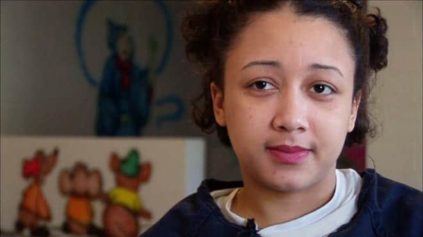
World-class entertainment and convention centers, popular sports franchises and the globe’s busiest airport have made the city of Atlanta a magnet for sexual deviants. With an estimated $32 billion in profit up for grabs, human trafficking is the third-largest international crime industry. Only drug and arms trafficking generate more. Yet experts say it is the fastest growing criminal trade.
A developmental psychologist at Georgia State University, a public research institution that weaves through the heart of the city, was one of the many residents awakened by the startling news.
“I was deeply shocked to read that Atlanta was on that list,” Dr. Ann Cale Kruger said in a phone interview with Atlanta Black Star.
In September of that same year, a public health study highlighting the city’s problem of commercial sexual exploitation of children revealed that Atlanta’s typical victim was an African-American girl between 12 and 13 years of age. “Hidden in Plain View: The Commercial Sexual Exploitation of Girls in Atlanta” exposed the seedy underground network of escort agencies, massage parlors and strip clubs that harbor these underage victims. The study’s accompanying map showed that areas with the highest crime activity were also, not surprisingly, the most socioeconomically disadvantaged.
“These are children who have either been snatched, abducted or lured or have been runaways and then find themselves in an unplanned, unintentional and horrific nightmare of being unable to leave — being basically enslaved,” Kruger noted.
Kruger, who teaches classes on educational psychology, special education, and communication disorders at the College of Education & Human Development, said she was particularly dismayed by the fact that a significant portion of the high-risk zones were clustered around schools in the Atlanta Public system. The college of education had a longstanding relationship with the district.
“These are the very schools where we send our students to conduct research or to become licensed psychologists, teachers – all of the different school services that we prepare our students for,” she said.
The associate professor was concerned that she regularly trained aspiring researchers and health practitioners in the local schools on how to create the best possible environment for children and provide the best services for them, yet this was happening in the same spaces where she worked.
She partnered with colleague Joel Meyers, executive director of the GSU Center for Research on School Safety, School Climate and Classroom Management, and the two called for a meeting of the minds: researchers, policymakers, social workers, law enforcement officials and other criminal justice representatives who were in the trenches, for some insight into the ongoing battle.
Stephanie Davis, adviser on women’s issues to then-mayor Shirley Franklin, had worked on the public health study. She was in attendance for the meeting.
“She would look out our conference room window and point to buildings,” Kruger recalled, “and say, ‘I know that in this building and in that building, and in that building, there are children being held there.’ It was so disturbing. It was an unreal feeling.”

Dr. Ann Cale Kruger is a developmental psychologist at Georgia State University. Courtesy GSU.
The conference left Kruger and Meyers reeling, but as prevention researchers, they felt compelled to do what they know best.
“Rather than deal with the horrible outcome of trafficking, we wanted to study. What are the lives like of the children who live in the neighborhoods? What might prompt the child to run away? What might prompt the child to be vulnerable to being lured or snatched?,” Kruger said. “And how can we work in schools to make the school environment the best and most supportive place for those girls and minimize the chance that something terrible like this will happen to them?”
The team headed back to the schools with a new mission: to talk to these high-risk children before they became lost to the cycle. Thanks to a well-connected coworker, they were able to organize an after-school intervention program.
Researchers divided the girls into small groups of 8-10 and recruited African-American female graduate students to facilitate the hour-long, weekly sessions. And they just listened.
“There’s a lot of research out there about statistically what is true about low-income kids or African-American kids,” Kruger noted. “There’s a lot of stuff out there, but nobody’s actually asked children to tell their story.”
After a couple of trust building, ice-breaking opening sessions the girls began to open up, painting a heartbreaking portrait of what it’s like to be a girl growing up in a neighborhood plagued by poverty and crime. One of their biggest issues was trust.
“They didn’t know a single person they could trust except perhaps their parents. They didn’t trust adults. They didn’t trust teachers. They didn’t trust counselors. They definitely didn’t trust each other as girls,” Kruger said.
Which could be a very dangerous reality in a neighborhood overrun with predators. If you can’t turn to your best friend for help, because you don’t trust her, you’re left completely vulnerable and exposed – the perfect victim. Because they had so little trust in anyone, researchers understood how necessary it was to present the girls with Black women as group leaders.
The social scientists started to notice another recurring theme: constant exposure to aggression.
“Aggressing with relationships. Aggressing physically kid on kid at school, but they also saw a lot of aggression in the neighborhood and in the home,” Kruger recalled. “We had one little girl who taped a razor blade under her tongue when she came to school because she felt she needed to be able to protect herself. Our young women facilitators went to school one day and there was a boy wandering around with a gun drawn.”
And the third and perhaps most troubling theme was the hypersexualized tone the girls took on when referencing themselves or other women. The girls identified other women by stereotyped body parts, hair texture and complexion, favoring a Eurocentric standard of beauty.
Kruger noticed the way the young girls seamlessly adopted the language of the adult sex industry to describe their own behaviors with boys.
“They would talk about a very normal schoolgirl thing: going to the skating rink on a Friday night, very normal, very age appropriate, but then they would say things like, ‘I have a regular customer at the skating rink.’ And ‘I have to go every Friday or I’ll lose my customer,’ ” Kruger said.
When facilitators asked them to elaborate on the purported commercial activity, the girls proudly declared they were giving “lap dances.” Kruger said that while the truth of the declarations was questionable, she was most disturbed by the girls’ tendency to use the terminology adults use when engaging in “very objectified, sexualized practices.”
“These girls were very familiar with the prostitutes in their neighborhood. They knew them by name. They had been with their parents and grandparents when the prostitutes had solicited their dad or grandfather,” Kruger said. “They talked about whether stripping versus prostituting was a better career choice because the former is legal and the latter isn’t.”
The team met every week to analyze the findings and, after getting past the initial shock, put together stories about what they were learning. The resulting journal articles chronicled the day-to-day challenges of African-American pre-teens, though, Kruger stressed, not every aspect was seen as a challenge.
“When they’re talking about who’s beautiful and who’s not; who’s this kind of thick but not that kind of thick; hair’s this length or that length, that’s not a challenge for them. That’s just how they see the world.”
And their worldview is undoubtedly shaped by America’s obsession with sex — a reflection of the country’s increasingly bold sexualization of children. From popular TV shows and commercials to Billboard’s top 10 hits and music videos, the girls are constantly bombarded with the message that sex sells, and they learn early on that a woman’s – or girl’s – only value is her desirability.
“And it does begin to chip away at their defenses. So when someone takes advantage of them sexually, it’s not earth shattering. It’s kind of what you’re expecting because that’s the script.”
And it’s something the researchers kept in mind when developing a curriculum to arm the young girls with better decision-making techniques.
“There’s also the lens of the historic stereotypes of African-American women and the contemporary stereotypes of African-American women that do that same thing,” Kruger observed. “That are oppressive and objectifying. We wanted in our curriculum to give girls some tools to be better consumers of media, to be more critical consumers of media.”
The final lessons in the 8-week programs encourage girls to become more future oriented when establishing their identities. It’s not a didactic curriculum, Kruger maintains.
“We’re supporting their thinking. [Supporting] them to think about a future that is beyond what they look like or the relationship they might have to a sex partner or how beautiful they’re going to be. To think about their worth as people.”
The program appears to be a success. Project P.R.E.V.E.N.T (Promoting Respect, Enhancing Value, Establishing New Trust) has been going strong every semester in Atlanta Public Schools since 2009. The girls say they want more trust-building groups, and some ask to come back for repeat sessions. Due to the transitional nature of the economically underprivileged, it is often difficult to keep track of individual girls, but Kruger said several case workers have reached out to the team for updates.
“We have heard from social workers who see them all the time that they hear them using some of the decision-making tools that we gave them when they have a dilemma to get through, and that makes us feel that they’re using some of it,” Kruger said.
Kruger estimates 70 girls have successfully completed the program. Understandably, the pupils become very attached to their facilitators by the end of the semester, and the feeling is mutual. At the conclusion of one extremely difficult term that took place in a transitional home, the team broke all their rules and took the girls out for dinner. One of the graduate students was a Spelman alumna, and arranged for the girls to experience a private tour of the honored historically Black college. Spelman officials rolled out the red carpet, hoping to drive home the message: This could be you.
Though the settings and groups have changed over the years, Kruger says one thing has remained the same: These girls don’t feel secure anywhere.
“All of the girls had those basic three things of trust, objectification and danger. They say they don’t feel safe. They don’t feel safe. One little girl said, ‘We know about that white man with those men that keep circling the neighborhood and we know to run when we see that van.’ Just that constant vigil, which isn’t good for your health.”

